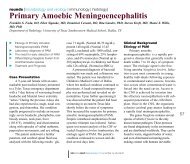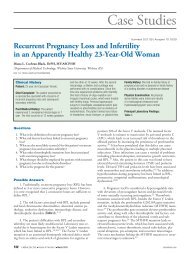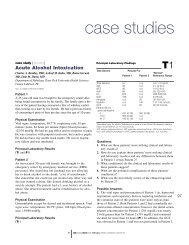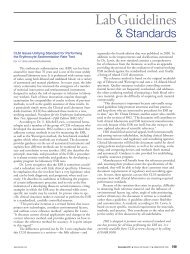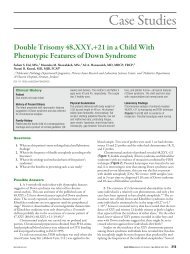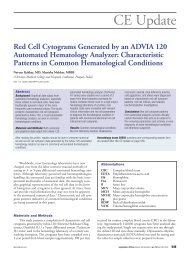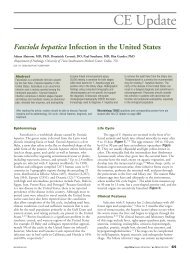Laboratory Variables That May Affect Test Results in Prothrombin ...
Laboratory Variables That May Affect Test Results in Prothrombin ...
Laboratory Variables That May Affect Test Results in Prothrombin ...
Create successful ePaper yourself
Turn your PDF publications into a flip-book with our unique Google optimized e-Paper software.
Summary of Mean INR <strong>Results</strong> on 25 Normal Patient Samples Before and After Local ISI Calibration<br />
Instrument Reagent Mean INR Us<strong>in</strong>g Mean INR Us<strong>in</strong>g Difference <strong>in</strong><br />
Vendor-Assigned ISI Locally Calibrated ISI INR Means (%)<br />
Diagnostica Stago/STA Neoplast<strong>in</strong>e CI+ 1.24 1.29 -3.9<br />
Thromborel S 1.12 1.13 -0.9<br />
Thromboplast<strong>in</strong> C+ 1.96 1.76 10.1<br />
Innov<strong>in</strong> 0.92 1.00 -8.5<br />
Sysmex CA 540 Neoplast<strong>in</strong>e CI+ 1.24 1.09 11.9<br />
Thromborel S 1.06 1.02 3.4<br />
Thromboplast<strong>in</strong> C+ 1.95 1.81 7.4<br />
Innov<strong>in</strong> 1.02 0.92 10.3<br />
Dade-Behr<strong>in</strong>g BCS Neoplast<strong>in</strong>e CI+ 1.24 1.16 6.9<br />
Thromborel S 1.06 1.02 3.5<br />
Thromboplast<strong>in</strong> C+ 1.77 1.57 11.1<br />
Innov<strong>in</strong> 0.90 1.07 -18.9<br />
Summary of Mean INR <strong>Results</strong> on 95 Patient OAT Samples Before and After Local ISI Calibration<br />
Instrument Reagent Mean INR Us<strong>in</strong>g Mean INR Us<strong>in</strong>g Difference <strong>in</strong> <strong>Results</strong> >10%<br />
Vendor-Assigned ISI Locally Calibrated ISI INR Means (%) Difference<br />
Diagnostica Stago/STA Neoplast<strong>in</strong>e CI+ 2.58 2.69 4.1 0.0<br />
Thromborel S 2.56 2.58 0.8 0.0<br />
Thromboplast<strong>in</strong> C+ 2.39 2.15 10.0 37.1<br />
Innov<strong>in</strong> 2.45 2.67 7.9 22.1<br />
Sysmex CA 540 Neoplast<strong>in</strong>e CI+ 3.46 2.90 16.1 63.9<br />
Thromborel S 2.69 2.58 4.1 0.0<br />
Thromboplast<strong>in</strong> C+ 2.82 2.60 7.8 27.8<br />
Innov<strong>in</strong> 2.49 2.25 9.6 39.2<br />
Dade-Behr<strong>in</strong>g BCS Neoplast<strong>in</strong>e CI+ 2.81 2.60 7.5 20.6<br />
Thromborel S 2.67 2.57 3.7 0.0<br />
Thromboplast<strong>in</strong> C+ 2.86 2.51 12.6 52.6<br />
Innov<strong>in</strong> 2.66 3.29 16.4 64.9<br />
serious patient mismanagement dur<strong>in</strong>g<br />
OAT. There is no current evidence that<br />
the hepar<strong>in</strong> neutralizers may neutralize<br />
the presence of low molecular weight<br />
hepar<strong>in</strong>. Each <strong>in</strong>stitution should check<br />
the effect of a therapeutic dose of unfractionated<br />
hepar<strong>in</strong> aga<strong>in</strong>st their<br />
reagent/<strong>in</strong>strument system.<br />
Possible Effect of a Lupus<br />
Anticoagulant (LA) on PT/INR<br />
The recommended therapeutic range<br />
of INR for OAT <strong>in</strong> patients with the presence<br />
of a LA is currently 2.5 to 3.5. This<br />
is still a controversial subject. It has<br />
been suggested that us<strong>in</strong>g the INR to<br />
monitor these patients may be <strong>in</strong>adequate<br />
due to <strong>in</strong>terference by the presence of a<br />
LA on the clot-based PT assay. Some<br />
<strong>in</strong>vestigators have suggested us<strong>in</strong>g the<br />
prothromb<strong>in</strong>-proconvert<strong>in</strong> assay <strong>in</strong> lieu<br />
of the PT/INR for patients with this disorder<br />
s<strong>in</strong>ce it doesn’t appear to be<br />
affected by a LAs <strong>in</strong>hibitory actions. 3<br />
Others have suggested measur<strong>in</strong>g coagulation<br />
factors II and X by either chromogenic<br />
or 1-stage clott<strong>in</strong>g assays based<br />
on at least 3 dilutions to lessen the LA<br />
<strong>in</strong>hibitory effect. 3 Other <strong>in</strong>vestigators<br />
found little effect of the presence of a LA<br />
on PT/INR results us<strong>in</strong>g different thromboplast<strong>in</strong>s<br />
and <strong>in</strong>struments. One small exception<br />
was a subgroup of 6 patients <strong>in</strong><br />
which a recomb<strong>in</strong>ant thromboplast<strong>in</strong><br />
©<br />
laboratorymedic<strong>in</strong>e> february 2003> number 2> volume 34<br />
T2<br />
T3<br />
(Innov<strong>in</strong>, Dade-Behr<strong>in</strong>g) was used. 3 One<br />
recent study performed a protocol to see if<br />
subjects who have the presence of anticardiolip<strong>in</strong><br />
antibodies without the presence<br />
of an LA to see if the INR assay was affected<br />
us<strong>in</strong>g local specific ISIs with 11<br />
different thromboplast<strong>in</strong>s. No effect on the<br />
INR results was observed. 18 In another<br />
study us<strong>in</strong>g 11 different LA positive, 11<br />
negative LA subjects, and 7 different<br />
thromboplast<strong>in</strong>s, the presence of an LA<br />
did not disturb the laboratory tests for<br />
monitor<strong>in</strong>g subjects on OAT. 19 Each <strong>in</strong>stitution<br />
should check their own reagent/<strong>in</strong>strument<br />
comb<strong>in</strong>ation with positive LA<br />
plasmas to determ<strong>in</strong>e if the LA <strong>in</strong>terference<br />
is an issue <strong>in</strong> their laboratory.<br />
127




